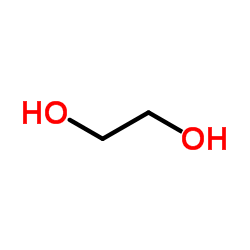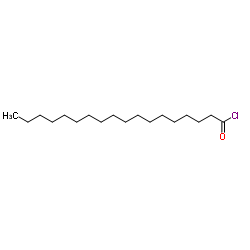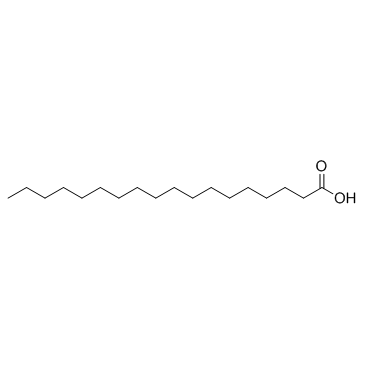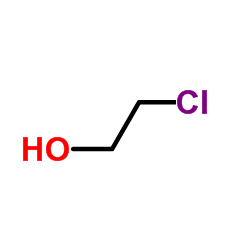111-60-4
| Name | 2-Hydroxyethyl stearate |
|---|---|
| Synonyms |
EINECS 203-886-9
ethylene glycol monostearate MFCD00051465 |
| Density | 0.913 g/cm3 |
|---|---|
| Boiling Point | 149 °C |
| Melting Point | 55-60 °C |
| Molecular Formula | C20H40O3 |
| Molecular Weight | 328.53000 |
| Flash Point | 240ºC |
| Exact Mass | 328.29800 |
| PSA | 46.53000 |
| LogP | 5.78340 |
Synonym:Ethylene Glycol Stearate; Glycol Stearate Section 2 - COMPOSITION, INFORMATION ON INGREDIENTS
Risk Phrases: None Listed. Section 3 - HAZARDS IDENTIFICATION EMERGENCY OVERVIEW
Not available. Potential Health Effects Eye: May cause eye irritation. Skin: May cause skin irritation. Ingestion: May cause irritation of the digestive tract. The toxicological properties of this substance have not been fully investigated. Inhalation: May cause respiratory tract irritation. The toxicological properties of this substance have not been fully investigated. Chronic: Not available. Section 4 - FIRST AID MEASURES Eyes: Flush eyes with plenty of water for at least 15 minutes, occasionally lifting the upper and lower eyelids. Get medical aid. Skin: Get medical aid. Flush skin with plenty of water for at least 15 minutes while removing contaminated clothing and shoes. Ingestion: Get medical aid. Wash mouth out with water. Inhalation: Remove from exposure and move to fresh air immediately. If not breathing, give artificial respiration. If breathing is difficult, give oxygen. Get medical aid. Notes to Physician: Section 5 - FIRE FIGHTING MEASURES General Information: As in any fire, wear a self-contained breathing apparatus in pressure-demand, MSHA/NIOSH (approved or equivalent), and full protective gear. Extinguishing Media: Use water spray, dry chemical, carbon dioxide, or chemical foam. Section 6 - ACCIDENTAL RELEASE MEASURES General Information: Use proper personal protective equipment as indicated in Section 8. Spills/Leaks: Vacuum or sweep up material and place into a suitable disposal container. Section 7 - HANDLING and STORAGE Handling: Avoid breathing dust, vapor, mist, or gas. Avoid contact with skin and eyes. Storage: Store in a cool, dry place. Store in a tightly closed container. Section 8 - EXPOSURE CONTROLS, PERSONAL PROTECTION Engineering Controls: Use adequate ventilation to keep airborne concentrations low. Personal Protective Equipment Eyes: Not available. Skin: Wear appropriate protective gloves to prevent skin exposure. Clothing: Wear appropriate protective clothing to prevent skin exposure. Respirators: Follow the OSHA respirator regulations found in 29 CFR 1910.134 or European Standard EN 149. Always use a NIOSH or European Standard EN 149 approved respirator when necessary. Section 9 - PHYSICAL AND CHEMICAL PROPERTIES Physical State: Solid Color: white Odor: Not available. pH: Not available. Vapor Pressure: Not available. Viscosity: Not available. Boiling Point: 149 deg C Freezing/Melting Point: 57 - 59 deg C Autoignition Temperature: Not available. Flash Point: Not available. Explosion Limits, lower: Not available. Explosion Limits, upper: Not available. Decomposition Temperature: Solubility in water: insoluble Specific Gravity/Density: Molecular Formula: Molecular Weight: 328.53 Section 10 - STABILITY AND REACTIVITY Chemical Stability: Stable under normal temperatures and pressures. Conditions to Avoid: Incompatible materials. Incompatibilities with Other Materials: Strong oxidizing agents, strong bases. Hazardous Decomposition Products: Carbon monoxide, carbon dioxide. Hazardous Polymerization: Will not occur. Section 11 - TOXICOLOGICAL INFORMATION RTECS#: CAS# 111-60-4: WI4100000 LD50/LC50: CAS# 111-60-4: Draize test, rabbit, skin: 500 mg/24H Mild. Carcinogenicity: 2-Hydroxyethyl stearate - Not listed by ACGIH, IARC, or NTP. See actual entry in RTECS for complete information. Section 12 - ECOLOGICAL INFORMATION Section 13 - DISPOSAL CONSIDERATIONS Dispose of in a manner consistent with federal, state, and local regulations. Section 14 - TRANSPORT INFORMATION IATA No information available. IMO No information available. RID/ADR No information available. Section 15 - REGULATORY INFORMATION European/International Regulations European Labeling in Accordance with EC Directives Hazard Symbols: Not available. Risk Phrases: Safety Phrases: S 24/25 Avoid contact with skin and eyes. WGK (Water Danger/Protection) CAS# 111-60-4: 1 United Kingdom Occupational Exposure Limits United Kingdom Maximum Exposure Limits Canada CAS# 111-60-4 is listed on Canada's DSL List. CAS# 111-60-4 is not listed on Canada's Ingredient Disclosure List. Exposure Limits US FEDERAL TSCA CAS# 111-60-4 is listed on the TSCA inventory. SECTION 16 - ADDITIONAL INFORMATION N/A |
CHEMICAL IDENTIFICATION
HEALTH HAZARD DATAACUTE TOXICITY DATA
|
| Hazard Codes | T |
|---|---|
| Risk Phrases | R60 |
| Safety Phrases | S24/25-S45-S36/37/39-S28-S27-S26-S53 |
| RTECS | WI4100000 |
| HS Code | 2915709000 |
|
~68% 
111-60-4 |
| Literature: Iwashita, Masazumi; Makide, Kumiko; Nonomura, Taro; Misumi, Yoshimasa; Otani, Yuko; Ishida, Mayuko; Taguchi, Ryo; Tsujimoto, Masafumi; Aoki, Junken; Arai, Hiroyuki; Ohwada, Tomohiko Journal of Medicinal Chemistry, 2009 , vol. 52, # 19 p. 5837 - 5863 |
|
~39% 
111-60-4 |
| Literature: THE MALAGHAN INSTITUTE OF MEDICAL RESEARCH; UNIVERSITY OF OTAGO; AGRESEARCH LIMITED Patent: WO2005/49631 A1, 2005 ; Location in patent: Page/Page column 61 ; |
|
~98% 
111-60-4 |
| Literature: Hosseini-Sarvari, Mona; Sodagar, Esmat Comptes Rendus Chimie, 2013 , vol. 16, # 3 p. 229 - 238 |
|
~78% 
111-60-4 |
| Literature: Sharghi, Hashem; Sarvari, Mona Hosseini Tetrahedron, 2003 , vol. 59, # 20 p. 3627 - 3633 |
|
~% 
111-60-4 |
| Literature: Journal of the Chemical Society, , p. 1918 |
|
~% 
111-60-4 |
| Literature: Journal of the Chemical Society, , p. 1043 |
|
~% 
111-60-4 |
| Literature: Journal of the Chemical Society, , p. 1043 |
|
~% 
111-60-4 |
| Literature: Bulletin de la Societe Chimique de France, , p. 927 US1733639 , ; |
| HS Code | 2915709000 |
|---|---|
| Summary | 2915709000. palmitic acid and its salts and esters. VAT:17.0%. Tax rebate rate:13.0%. . MFN tariff:5.5%. General tariff:30.0% |









